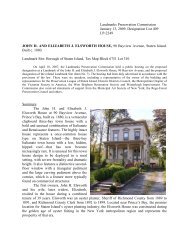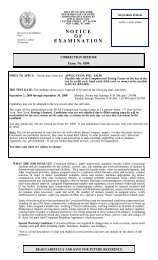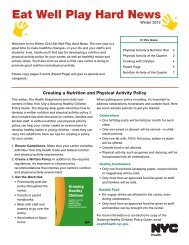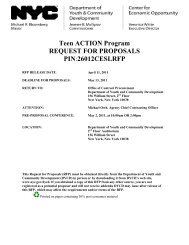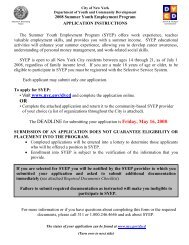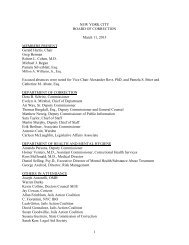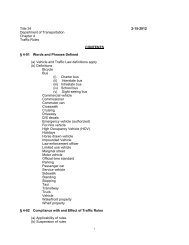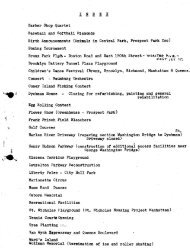Create successful ePaper yourself
Turn your PDF publications into a flip-book with our unique Google optimized e-Paper software.
New York City Department of Health and Mental Hygiene<br />
Physical Activity and Nutrition<br />
Gotham Center<br />
42-09 28th Street, 9th Floor, CN-46<br />
Queens, NY 11101-4132<br />
Call 212-788-2226 or email ewph@health.nyc.<strong>gov</strong>.<br />
Questions? Need more information?<br />
Presorted First Class<br />
U.S. POSTAGE<br />
PAID<br />
Department of Health<br />
& Mental Hygiene<br />
<strong>Eat</strong> <strong>Well</strong> <strong>Play</strong> <strong>Hard</strong> <strong>News</strong><br />
Spring 2011<br />
Welcome to the Spring 2011 <strong>Eat</strong> <strong>Well</strong> <strong>Play</strong> <strong>Hard</strong> <strong>News</strong>. The season’s<br />
National TV Turnoff Week is a great opportunity to encourage children to<br />
turn off the TV and boost physical activity.<br />
This issue focuses on the importance of limiting TV, video games and<br />
other recreational screen time and getting kids more active. Inside you’ll<br />
find ideas for fun, screen-free activities – indoors and outdoors. You’ll<br />
also hear from child care centers around the city on what they’re doing<br />
to promote physical activity and good nutrition.<br />
Less Screen Time Equals More Active Time<br />
Tips for Increasing Active <strong>Play</strong><br />
Studies show that too much screen time from TV or<br />
videos at an early age affects a child’s physical and<br />
mental health. For example:<br />
Time spent watching TV or videos cuts into time<br />
when kids can be active.<br />
Children often overeat or snack on high-calorie,<br />
high-fat foods when watching TV.<br />
The more time kids spend watching TV or videos,<br />
the more likely they are to be overweight or obese.<br />
Children exposed to media violence are more likely<br />
to engage in aggressive behavior and use violence<br />
to solve problems.<br />
Active play is important for physical, mental and social<br />
development. It helps preschoolers learn how to get<br />
along with others, explore, create, make choices and<br />
feel good. In addition, daily physical activity gives<br />
children more energy, helps develop bones and<br />
muscles, and improves sleep.<br />
Child care centers in New York City are required to<br />
provide at least 60 minutes of physical activity each<br />
day, including at least 30 minutes of structured<br />
physical activity for children three years of age and<br />
older. In addition, child care centers are not allowed to<br />
provide educational TV or video viewing for children<br />
younger than two years of age, and no more than 60<br />
minutes a day for those two years of age and older.<br />
Here are some ideas to get children moving in your<br />
In this Issue<br />
Physical Activity Star 2<br />
Nutrition Star 2<br />
Physical Activity of the Quarter 3<br />
Cooking with Kids 4<br />
Parent Page 5<br />
Nutrition Activity of the Quarter 7<br />
classroom. Remember, children follow adults’ examples.<br />
If you’re more active, they’ll be too.<br />
Indoors<br />
1. Make an obstacle course using pillows, boxes and<br />
hula hoops. Have kids go over, through and around<br />
obstacles.<br />
2. Dance to lively music.<br />
3. <strong>Play</strong> catch or basketball with a yarn ball or<br />
beanbag, and a basket or box.<br />
4. <strong>Play</strong> charades, twister or simon says.<br />
5. <strong>Play</strong> drums or other instruments and march around<br />
the room.<br />
6. Roll out bubble wrap. Have kids form a train to<br />
stomp out the bubbles as they chug along.<br />
7. Organize Move-To-Improve fitness breaks.<br />
8. Dance to lively music.<br />
Outdoors<br />
1. Walk through the local park or around the<br />
neighborhood, and discover what’s in the area.<br />
2. Blow bubbles and chase them.<br />
3. Have fun with a hula hoop. Roll the hoop and chase<br />
after it, or lay it on the ground and hop in and out.<br />
4. <strong>Play</strong> hopscotch or freeze-tag.<br />
5. Plant a flower, vegetable or herb garden.<br />
6. Organize a scavenger hunt. Look for flowers,<br />
colorful leaves or small rocks.<br />
7. Use a ball and empty plastic bottles to bowl.
Physical Activity Star: Washington Heights Day Care Center<br />
The children and staff at Washington Heights Day<br />
Care Center are excited about moving more. Over the<br />
past three years, the center has integrated fitness<br />
breaks that combine dancing, music and other<br />
physical activities into the day. “We recently had kids<br />
demonstrate how plants grow,” said center director<br />
Nereida Hill. “Some children were rolling like seeds.<br />
Others carried scarves and acted as water to help the<br />
seeds grow. And still others circled around like the<br />
sun to help the leaves grow.”<br />
Since introducing the fitness breaks, “the children are<br />
more energetic, curious and enthusiastic in class,”<br />
explained Ms. Hill. “The fitness breaks are really<br />
stimulating the children’s brains and increasing their<br />
learning capacity.”<br />
Nutrition Star: Chung Pak Day Care Center<br />
The Chung Pak Day Care Center in lower Manhattan<br />
recently implemented the <strong>Eat</strong> <strong>Well</strong> <strong>Play</strong> <strong>Hard</strong> program.<br />
According to center director Mary Sikarevich, the<br />
program has introduced children and parents to new,<br />
healthy foods, outside their traditional diet. <strong>Eat</strong> <strong>Well</strong><br />
<strong>Play</strong> <strong>Hard</strong> staff also trained teachers on the program’s<br />
curriculum and provided tips on encouraging healthy<br />
behaviors among children and parents. The center<br />
enlisted a volunteer translator for the most popular<br />
parent workshops, which often bring in more than 40<br />
participants.<br />
The recent Healthy Snacks workshop was a huge hit,<br />
with parents clamoring for the tuna pita pockets<br />
recipe. Another workshop focused on limiting TV,<br />
video games and other screen time and increasing<br />
physical activity. Chung Pak staff gave out Cool<br />
Culture passes, which offer free access to nearly 100<br />
museums, gardens and other events around the city.<br />
Children, parents and staff also visited a local orchard,<br />
picked apples and then made apple sauce in class.<br />
According to Ms. Sikarevich, the greatest success has<br />
been the “excitement and conversations generated by<br />
the increased emphasis on nutrition.” Getting<br />
everyone excited about nutrition has led to the<br />
sharing of ideas, recipes and strategies for healthful<br />
eating. The kids are excited about trying new foods<br />
and helping with meals at home. In addition, parents<br />
are incorporating new foods from the workshops into<br />
home-cooked meals.<br />
Here are tips from Chung Pak staff on implementing a<br />
successful nutrition education program:<br />
Make activities fun and make sure food tastes<br />
good.<br />
Hand out small giveaways to workshop attendees.<br />
Open up workshops to all family members,<br />
including grandparents and siblings.<br />
Hold workshops near the end of the day, when<br />
childcare is still available.<br />
Get teachers excited about nutrition; they, in turn,<br />
will excite the kids and parents.<br />
Supplies<br />
Serving spoons<br />
Serving bowls<br />
Paper plates<br />
Plastic knives<br />
Measuring cups<br />
Blender<br />
Small cups<br />
Small sealable containers<br />
Napkins<br />
Ingredients<br />
(for 20 servings, ½ cup per serving)<br />
4 to 5 ripe bananas<br />
3 ¼ cups fruit, such as strawberries,<br />
blueberries or peaches<br />
4 ½ cups low-fat vanilla yogurt<br />
1 ½ cups orange juice<br />
Preparation<br />
Wash fresh fruit.<br />
Wash and cut bananas (with peel) into quarters.<br />
Place each fruit in a separate serving bowl with serving spoon.<br />
Steps<br />
Nutrition Activity of the Quarter: Fruit Shake-Up<br />
Explain that:<br />
° The class will be making a fruit shake.<br />
° It’s made out of fruit and juice, and it will give us lots of energy to move and play.<br />
° Physical activity is important to keep us healthy and strong.<br />
° We’ll move our bodies while we make our shakes.<br />
Have children peel and cut prepared bananas into smaller, 1 to 2 inch pieces, and put in blender.<br />
Have class measure out fruit and yogurt and put in blender.<br />
Close lid, and blend until smooth. Ask class to imagine they’re a blender. Tell them to flap their arms and<br />
spin around like a helicopter.<br />
Pour fruit mixture into six separate sealable containers, add 1/4 cup of orange juice to each, and seal<br />
tight.<br />
Have children take turns shaking up containers while they shake and wiggle.<br />
Pour into small cups.<br />
Ask children to describe what the shake tastes like.<br />
2 <strong>Eat</strong> <strong>Well</strong> <strong>Play</strong> <strong>Hard</strong> <strong>News</strong>, Fall 2010 <strong>Eat</strong> <strong>Well</strong> <strong>Play</strong> <strong>Hard</strong> <strong>News</strong>, Fall 2010 7
<strong>Eat</strong> <strong>Well</strong> <strong>Play</strong> <strong>Hard</strong> <strong>News</strong><br />
Familia Destacada: Eunice Williams<br />
Salsa de Mango y Garbanzos<br />
Página para los padres<br />
Eunice Williams, abuela de Gabriella, una niña de cuatro años de edad que asiste a la<br />
guardería infantil Starlight en Queens, recientemente participó en los seis talleres de<br />
nutrición de <strong>Eat</strong> <strong>Well</strong> <strong>Play</strong> <strong>Hard</strong>. La Sra. Williams aprendió sobre cómo comer<br />
saludablemente y ha tratado varias de las recetas de los talleres. A ella y a su familia les<br />
gusta en especial la salsa de mango y garbanzos. (Lea la receta más adelante.)<br />
Consejos para reducir el tiempo frente a la televisión y hacer a los niños más activos<br />
El tiempo que pasan viendo la televisión o videos reduce<br />
el tiempo que los niños pueden estar activos. Puede<br />
reducir el deseo natural de un niño de jugar, ser creativo<br />
e interactuar con los demás. El juego activo es importante<br />
para el desarrollo de un niño. Ayuda a los niños a aprender<br />
a llevarse bien con otros niños, a explorar, a crear y tomar<br />
decisiones. También ayuda a desarrollar los huesos, los<br />
músculos y mejora el sueño. Spring’s National TV Turnoff<br />
Week es una gran oportunidad para animar a sus hijos a<br />
apagar la TV y ser activo. Estas son algunas actividades<br />
divertidas sin la televisión:<br />
Interiores<br />
Haga una pista de obstáculos usando almohadas,<br />
cajas y hula-hoops. Muévase, pase por y alrededor<br />
Ingredientes<br />
1 (15½ onza) de garbanzos,<br />
escurridos y enjuagados<br />
1½ tomates<br />
1 mango<br />
2 cebollas<br />
1 cucharada de aceite vegetal<br />
1 cucharada de vinagre blanco<br />
½ limón<br />
1 cucharadita de comino molido<br />
½ cucharadita de ajo en polvo<br />
Tiempo de preparación: 15 minutos<br />
Tamaño de ración: ½ taza<br />
Rinde 10 porciones<br />
Primavera 2011<br />
de los obstáculos.<br />
Haga que su hijo ayude en las tareas domésticas<br />
sencillas, como desempolvar o recoger los juguetes.<br />
Hagan juntos bocadillos saludables, o ponga música<br />
y bailen.<br />
Cree instrumentos musicales con artículos que se<br />
hayan en la casa, como ollas, sartenes, latas y<br />
botellas vacías, y organice una banda de música.<br />
Exteriores<br />
Visite el zoológico o una granja local.<br />
Camine en el parque local y juegue en las áreas de<br />
recreo.<br />
Haga burbujas.<br />
Juegue a la rayuela o a la estatua.<br />
Idea Para un bocadilla Saludable<br />
1. Lave los tomates, el mango y las cebollas.<br />
2. Pele el mango.<br />
3. Corte los tomates, el mango y las cebollas en trozos pequeñitos.<br />
4. Escurra y enjuague los garbanzos.<br />
5. Exprima el jugo del limón.<br />
6. En un tazón grande combine los ingredientes y mezcle bien.<br />
7. Sirva inmediatamente, o cubra y refrigere por cuatro horas para que<br />
se mezclen los sabores.<br />
8. Sirva con pan pita horneado o con chips de maíz. Disfrute.<br />
Haga que su hijo le ayude con los pasos marcados en negrita<br />
6 <strong>Eat</strong> <strong>Well</strong> <strong>Play</strong> <strong>Hard</strong> <strong>News</strong>, Fall 2010<br />
Steps<br />
Physical Activity of the Quarter: Cooking Fun<br />
1. Explain that cooking is fun and a great alternative to watching TV.<br />
2. Have class do suggested movements while they imagine preparing different foods.<br />
We’re first going to warm up:<br />
Stir oatmeal: Circle hips round and round<br />
Slice bananas: Bounce up and down<br />
Shake low-fat milk: Wrap arms around and twist side to side.<br />
Beat eggs: Run in place with knees high.<br />
Bake potatoes: Jump, raise arms to the side and back down.<br />
Stir chicken noodle soup: Circle hips.<br />
Chop mixed vegetables: Jump up and down.<br />
Slice low-fat cheese: Kick legs straight up and down.<br />
Chill water: Shiver.<br />
Mix fruit salad: Shake entire body<br />
3. Ask kids to come up with additional movements.<br />
4. Ask class to imagine they’re cleaning up.<br />
Wash dishes: Circle one hand over the other.<br />
Put dishes away: Reach up high.<br />
Put leftovers in fridge: Bend down low.<br />
Wash hands: Rub hands together.<br />
3
Makes 24 mini pizzas<br />
Cooking with Kids: Healthy Mini Pizzas<br />
Ingredients<br />
1 green pepper<br />
1/2 onion<br />
12 whole-wheat English muffins<br />
3 cups tomato sauce (preferably low-sodium)<br />
12 oz. low-fat mozzarella cheese<br />
Optional: Add other vegetables for toppings<br />
Supplies<br />
Baking sheet<br />
Cutting boards<br />
Knife<br />
Can opener<br />
Spoons<br />
Measuring spoons<br />
Grater<br />
Pot holders<br />
Wax paper<br />
Preparation<br />
Preheat oven to 400 degrees.<br />
Shred low-fat cheese on wax paper, and set aside.<br />
Open tomato sauce.<br />
Wash pepper. Remove stem and seeds, and chop into small pieces.<br />
Peel onion and chop into small pieces.<br />
Steps<br />
Demonstrate steps before having children do them.<br />
Have each child:<br />
° Place a muffin half onbaking sheet.<br />
° Spoon and spread 2 tablespoons of tomato sauce on each half.<br />
° Put chopped peppers and onions on muffin half, as desired.<br />
° Sprinkle 3 tablespoons shredded cheese on each half.<br />
Put baking sheet in oven, and bake for 15 minutes.<br />
Enjoy.<br />
4 <strong>Eat</strong> <strong>Well</strong> <strong>Play</strong> <strong>Hard</strong> <strong>News</strong>, Fall 2010<br />
<strong>Eat</strong> <strong>Well</strong> <strong>Play</strong> <strong>Hard</strong> <strong>News</strong><br />
Family Spotlight: Eunice Williams<br />
Mango and Black-Eyed Pea Salsa<br />
Parent Page<br />
Eunice Williams, grandmother of four-year-old Gabriella, who attends the Starlight<br />
Day Care Center in Queens, recently took part in all six <strong>Eat</strong> <strong>Well</strong> <strong>Play</strong> <strong>Hard</strong> nutrition<br />
workshops. Ms. Williams learned about eating healthfully and has tried many<br />
workshop recipes. She and her family especially like the Mango and Black-Eyed<br />
Pea Salsa. (See recipe below.)<br />
Tips for Reducing Screen Time and Getting Kids Active<br />
Time spent watching TV or videos cuts into time when<br />
kids can be active. It can reduce a child’s natural desire to<br />
play, be creative and interact with others. Active play is<br />
important for a child’s development. It helps kids learn<br />
how to get along with others, explore, create and make<br />
choices. It also helps develop bones and muscles, and<br />
improves sleep. Spring’s National TV Turnoff Week is a<br />
great opportunity to encourage your kids to turn off the TV<br />
and get active. Here are some fun, screen-free activities:<br />
Indoors<br />
Make an obstacle course using pillows, boxes and<br />
hula-hoops. Go over, through and around obstacles.<br />
Ingredients<br />
1 (15½-ounce) can black-eyed<br />
peas, drained and rinsed<br />
1½ tomatoes<br />
1 mango<br />
2 green onions<br />
1-tablespoon vegetable oil<br />
1-tablespoon white vinegar<br />
½ lime<br />
1-teaspoon ground cumin<br />
½-teaspoon garlic powder<br />
Prep time: 15 minutes<br />
Serving size: ½ cup<br />
Makes 10 servings<br />
Spring 2011<br />
Have your child help with simple household chores,<br />
like dusting or picking up toys.<br />
Make healthy snacks together, or put on music and<br />
dance.<br />
Make musical instruments out of items around the<br />
house, like pots, pans and empty cans and bottles,<br />
and create a marching band.<br />
Outdoors<br />
Visit the zoo or a local farm.<br />
Walk through the local park and play on the<br />
playground.<br />
Blow bubbles.<br />
<strong>Play</strong> hopscotch or freeze-tag.<br />
1. Wash tomatoes, mango and green onions.<br />
2. Peel mango.<br />
3. Chop tomatoes, mango and green onions into tiny pieces.<br />
4. Drain and rinse peas.<br />
5. Squeeze juice out of lime.<br />
6. Combine ingredients in large bowl and mix well.<br />
7. Serve right away, or cover and refrigerate up to four hours so flavors<br />
mix.<br />
8. Serve with baked pita or corn chips. Enjoy.<br />
Have your child help with the bold steps.<br />
Healthy Snack Idea<br />
<strong>Eat</strong> <strong>Well</strong> <strong>Play</strong> <strong>Hard</strong> <strong>News</strong>, Fall 2010 5



